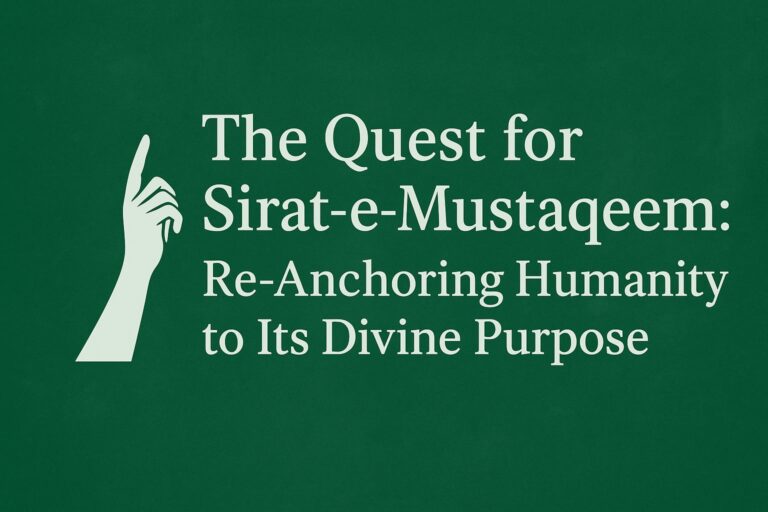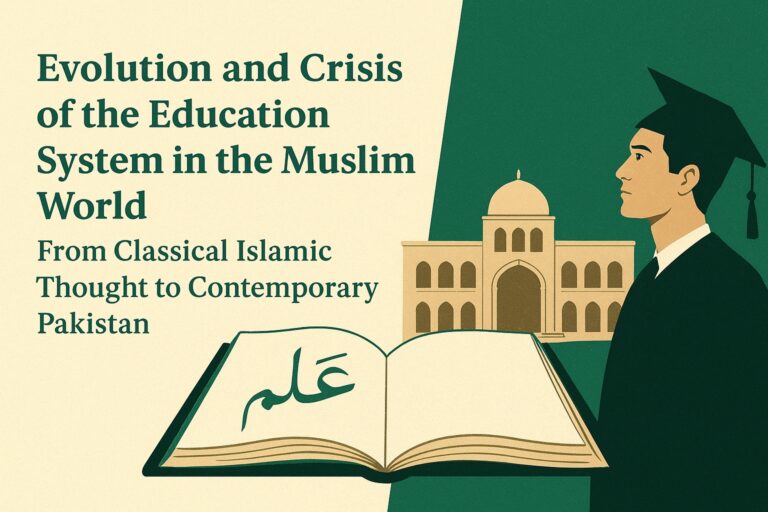The Straight Path: The Human Journey From Covenant to Habit
Introduction: The First Promise and the Forgotten Road
There are moments in the story of humanity that do not belong to time; they belong to eternity. One such moment is when all souls stood before their Creator, and He asked them:
“Am I not your Lord?”
They said: “Yes, indeed.” (Qur’an 7:172)
It was the first affirmation, the first identity, the first pledge ، and the first direction ever given to the human spirit.

Long before a single foot touched the dust of this world, the direction of human life had already been defined. A covenant was placed at the heart of existence, not as an external law but as an inner compass. Every revelation that descended afterwards, every prophet who walked the earth, and every command that shaped civilisations was anchored in that moment.
And yet, the earth is full of roads that pull man in every direction except the one he promised to walk.
In this divergence lies the tragedy of ages.
In returning to that promise lies the salvation of ages.
Sirat-e-Mustaqeem — “the Straight Path” is not a metaphor, not a philosophy, not a cultural aspiration. It is the divine way of life, the only way of life that matches the human soul’s original yes. Anything beyond this boundary is a deviation. Anything that contradicts this covenant is a step into inner estrangement.
This article unfolds that truth: that every tier of human existence, from spiritual identity to state institutions to personal habits, must be governed by the Covenant of Alastu. Where the chain breaks, the compass fails, and deviation begins.
Let us now move from literary emotion to theological precision.
1. The Covenant of Alastu: The Foundational Alignment
(Qur’anic Reference: Surah Al-A‘raf 7:172)
The Covenant of Alastu Bi Rabbikum is not an abstract theological relic. It is the constitutional moment of human existence.
1.1 What the Covenant Establishes
-
Identity: Human beings belong to Allah.
-
Authority: Allah alone is the ultimate source of law, morality, and purpose.
-
Accountability: Human life is a test, and every choice is weighed.
-
Direction: Human decisions must remain aligned with divine guidance.
This covenant predates:
-
All religions
-
All civilizations
-
All human laws
-
All cultures
-
All relationships
It is the mother-framework.
Everything else is subordinate.
Any system of life that contradicts it is structurally invalid, spiritually void, and morally misguided.
2. Revelation and Religion: The First Organisational Layer of the Covenant
After the covenant came guidance.
After the promise came prophethood.
Every prophet was sent to realign humanity with the original pledge. Every scripture — including the Qur’an — is a manual explaining what “Yes, You are our Lord” means in practical life.
Thus:
Religion = Operationalisation of the Covenant
To distort religion is to distort the covenant.
To replace divine law with human desire is to sever the chain from its first link.
3. Constitution and Law: Systemic Alignment with the Covenant
When human communities form societies, they create systems to govern themselves. Islam does not deny this; it provides the principles to guide it.
3.1 A Constitution, In Light of the Covenant, Must:
-
Recognise divine sovereignty
-
Uphold justice as defined by revelation
-
Protect rights bestowed by the Creator
-
Prevent moral, social, and economic injustice
-
Ensure accountability of rulers and institutions
A constitution that contradicts divine principles is a constitutional betrayal of the primordial covenant.
4. State Policies: Translating Divine Direction into Governance
Policies determine:
-
What a society values
-
How resources are distributed
-
What behaviours are encouraged
-
What injustices are prevented
If policies are shaped by political convenience, economic greed, or foreign ideological trends — rather than divine guidance — the chain breaks at the level of governance.
4.1 Where Deviation Commonly Occurs
-
Policies that legalise what Allah forbade
-
Policies that forbid what Allah permitted
-
Policies that ignore the rights of the poor
-
Policies that safeguard elite interests over collective justice
-
Policies that elevate material progress over moral integrity
Once deviation begins at this level, society drifts collectively off-axis.
5. Institutional Frameworks: The Architecture of Collective Action
Institutions convert policies into practice.
If institutions align with the covenant, society becomes balanced and just.
If they deviate, society becomes oppressive and chaotic.
5.1 Institutions Under the Divine Framework
Every institution — judicial, economic, educational, military, administrative — must operate within divine limits.
They must:
-
Safeguard justice
-
Promote truth
-
Uphold rights
-
Eliminate corruption
-
Protect human dignity
-
Maintain accountability
When institutions operate by their own man-made ethics, divorced from revelation, the chain breaks a third time.
6. SOPs, Checklists, and Processes: The Micro-Mechanics of Divine Alignment
Even the processes, procedures, SOPs, and checklists of institutions must reflect the covenant.
An SOP that encourages cheating, opacity, red tape, or injustice is a silent rebellion against the divine order.
An audit checklist that ignores exploitation or corruption is a betrayal of the covenant.
Process design that violates fairness is a deviation in technical language.
7. Personal Habits: The Final and Smallest Link — Yet the Most Crucial
A man’s habits are his silent constitution.
If the covenant does not govern his:
-
Eating
-
Speaking
-
Dealing
-
Dressing
-
Spending
-
Planning
-
Thinking
-
Relationships
-
Promises
-
Time management
…then the entire structure collapses at the foundation.
Sirat-e-Mustaqeem begins at the soul but ends in habits.
The divine chain reaches its destination only when the smallest habit aligns with the greatest covenant.
Where this final link breaks, deviation enters through personal life and spreads outward into families, institutions, states, and eventually civilisations.
Conclusion: The Straight Path , A Return, Not a Discovery
Humanity’s most important task is not to invent a new moral order.
It is to return to the one it already promised.
Sirat-e-Mustaqeem is not a road we must search for;
it is the road we once agreed to walk.
The Covenant of Alastu Bi Rabbikum is not a theological memory;
it is the spiritual spine of human existence.
When this covenant governs religion, law, policy, institutions, processes, and personal habits, life flows in the direction for which it was created.
But when any link breaks — anywhere in the chain — man moves off-axis, like a star slipping out of its orbit. Deviation does not begin in grand rebellions; it begins in silent fractures.
The straight path is the path of coherence.
A path where the inner promise and outer life face the same direction.
A path where the human being becomes what he was meant to be.
And in the final analysis, the Straight Path is not a road on earth.
It is the continuation of a promise made before time —
a promise that still echoes in every human soul.



